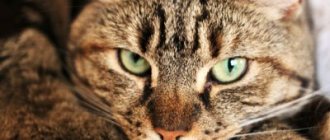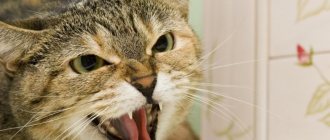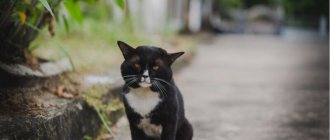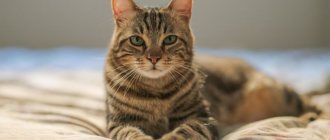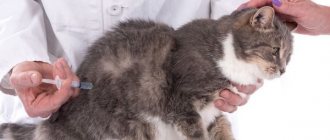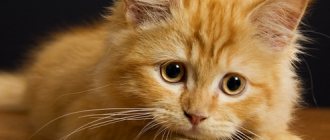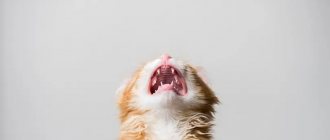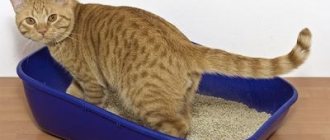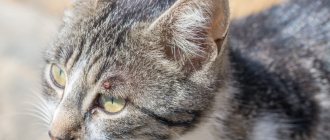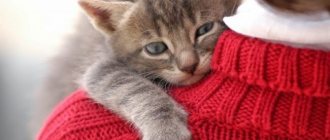The reasons why a cat's pupils become dilated can be varied. Often this condition is observed at the moment of strong overexcitation of the animal, play, or hunting. However, as soon as the cat calms down, the pupils become constricted again. If the pupils are constantly enlarged or only one pupil has narrowed, and other pathological symptoms are present, you should not hesitate to visit the veterinarian, because this condition may indicate an internal disorder.
Main reasons
Stress and nerves
A common reason that causes wide pupils. If the animal senses something is wrong or becomes very frightened, visual functions become more acute. This helps to notice danger in a timely manner and respond to it immediately. Unfamiliar surroundings, strangers and objects in the house also make the animal worried and wary.
There is a breed of cat, for example, the Singaporean, which has a highly developed maternal instinct. The mother cat constantly protects and protects the kitten, and if the baby is suddenly separated and given to other owners, the animal will begin to worry a lot and cannot find a place for itself. Due to stress, the pupils immediately dilate, the cat becomes wary, and may stop trusting the owner and hide the rest of the kittens. A cat’s pupil can also become wide during a joyful event, for example, if the owner bought a new, interesting toy with which he can “go wild” and play.
Hormonal instability
A sign of estrus in an animal is a combination of this symptom with frequent visits to the toilet.
If a cat has dilated pupils over the entire eye, she constantly meows, eats poorly, sleeps and often goes to the toilet, this means that the pet is ready to mate at this moment. When the level of hormones in a cat increases, its habits change dramatically; sometimes the animal cannot be recognized by its behavior, because it shows signs of aggression, and sometimes even disappears from the house for several days. When the heat passes, the cat's eyes narrow on their own, and the animal no longer worries.
Diseases
Pupils also enlarge due to the progression of various diseases of the visual organs. In addition to enlargement, the owner will notice other pathological symptoms that should be a reason to visit the veterinarian. Often, large pupils in a cat are caused by the following pathologies:
- Retinal atrophy. The pet's fear of the dark increases, he also suddenly begins to be afraid of heights, and bumps into surrounding objects. The iris is cloudy, covered with a white film.
- Lens luxation. With this disorder, the vitreous body moves in any direction. The animal sees poorly, its field of vision is significantly narrowed.
- Glaucoma. It is a consequence of another equally dangerous eye pathology - increased intraocular pressure. Just like a person’s, a cat’s eyes no longer see normally, the cornea becomes redder, the mucous membrane becomes inflamed, severe pain and lacrimation occur. Soon the pupils become covered with white films, and the animal loses its vision.
Different sizes of pupils in a pet are a sign of serious health problems.
A condition is considered dangerous when the eyes are of different sizes. If one pupil is narrowed and the other is wide, this may indicate intracerebral hemorrhage, disruption of the cerebellum, eye cancer, head injury, or the development of neurological disorders. Round and always enlarged pupils are also a sign of arterial hypertension, renal pathology, diseases of the digestive tract, and severe poisoning.
The wonders of the cat's eye
Cat's eyes correspond to the lifestyle of a nocturnal predator, however, contrary to myths, cats cannot see in absolute darkness. The visual analyzer adapts to different light levels, with the pupil acting as a diaphragm that regulates the intensity of light entering the retina.
Its vertical-oval shape is explained by the fact that in bright light the iris contracts unevenly with the help of circular muscle fibers. In this case, only the central part of the optical system of the eye is used, forming a clear color image. Cats are able to distinguish colors, but in bright light they see worse than humans.
Night vision. The priority for cats is night vision acuity, which allows them to navigate in minimal light conditions. After all, it is at night and at dusk that owners can observe the activity of the “domestic tiger”, spending daylight hours in a lazy half-asleep.
The light sensitivity of a cat's eye is 7 times higher than that of a human and is determined by several biological mechanisms, one of which is dark adaptation.
In this case, the radial muscles of the iris are stretched with an increase in the area of the pupil and its transformation into a circle. An open “diaphragm” allows the maximum possible light flux to reach the retina.
Dangerous symptoms
If a cat has constantly dilated pupils as a result of any internal disorders, there will certainly be accompanying symptoms that cannot be ignored. It is dangerous to postpone a visit to the doctor if the following pathological signs are additionally observed:
- the pupils are always dilated and do not react to light;
- fields of vision are narrowed;
- corneal clouding;
- redness of the conjunctiva;
- photophobia;
- hanging lacrimation;
- rapid breathing;
- nausea, vomiting, the cat staggers when walking;
- eyes constantly dart, the animal cannot concentrate its gaze at a certain point;
- stiffness of movement, disorientation;
- temperature increase.
Diagnostics
Anisocoria in an animal requires prompt consultation with a doctor.
If the cat’s pupils are dilated all the time or it becomes noticeable that one is enlarged and the other is narrowed, you should not wait for the condition to normalize on its own. It is necessary to take your pet to a veterinarian as soon as possible, who, after determining the causes of the pathology, will advise what to do next.
At the initial appointment, the doctor will examine the eyes and try to find out the root cause under the influence of which the pupils have enlarged. To confirm the diagnosis, the following diagnostic procedures are additionally prescribed:
- ophthalmoscopy;
- Ultrasound;
- ECG;
- radiography;
- measurement of intraocular pressure;
- biomicroscopy;
- fluorescein angiography;
- general clinical and biochemical blood test.
If different pupils are observed in a cat, the following is carried out:
- CT or MRI of the brain;
- electroretinography;
- cerebrospinal fluid analysis.
Good to know
- Anatomy of the liver in cats
- The structure and functions of the thyroid gland in cats
- Measuring blood pressure in cats before general anesthesia
- Current role of dexmedetomidine in clinical veterinary anesthesia and intensive care
- Dynamic testing of thyroid function in cats
- Gabapentin in cats and dogs (all pros and cons, indications, contraindications, doses, features of use, instructions for use)
- Information content of hematological and echocardiographic preoperative screening indicators
- Historical background on hyperthyroidism in cats
- Hyperthyroidism in older cats
- Cardiac hypertrophy in domestic cats
- Analysis of anamnestic data during preoperative examination of small domestic animals
- Study of anamnestic data in cats that require manipulation under general anesthesia
- Method for measuring blood pressure in cats
- ICD in cats (diagnosis and symptoms)
- Hyperthyroidism is suspected, but serum T4 concentration is normal
- Acute gastroenterocolitis in dogs (etiology, pathogenesis, diagnosis and treatment)
- Reducing mortality during anesthesia is an important task of veterinary anesthesiology
- Thrombosis in cats (general information, etiology, pathogenesis, clinical picture, diagnosis and treatment)
- Urolithiasis of small animals (etiology, pathogenesis, diagnosis and treatment)
- Congestive cardiomyopathy in cats (What is it? How to protect your pets)
- Gastrointestinal tract in dogs (anatomy and physiology)
- Levofloxacin in pets
- Concentrations of total and free thyroxine in cats (T4 hormone)
- Surgical treatment for hyperthyroidism in cats
- Treatment and prevention of urolithiasis in animals
- Urinary tract stones in cats and dogs (causes and mechanisms of formation)
- Liver lipidosis in domestic cats (symptoms and treatment)
- Performing laboratory tests in cats with hyperthyroidism
- Treatment of hepatolipidosis in domestic cats
- Pathogenesis and colloid theory of stone formation in urolithiasis
- What preparation is necessary for a cat to undergo general anesthesia?
- Causes of stone formation in dogs and cats
- Ondansetron for dogs (mechanism of action, blockade of serotonin receptors)
- Urolithiasis in Russia (urolithiasis). Scourge of modernity
- Acute gastroenteritis in dogs (pirchinas, pathogenesis, diagnosis and treatment)
- What function does the liver perform in the body of animals and humans?
- Misdiagnosis of hyperthyroidism based on falsely high serum total T4 (or free T4) concentration
- Drugs for the treatment of hypertension associated with hyperthyroidism in cats
- Primary Cardiomyopathy in Cats (History, Causes, Pathogenesis)
- Pharmacological treatment of cats with hyperthyroidism
- Endogenous hyperthyroidism in cats (causes, definition, characteristics)
- Monitoring during anesthesia in cats (Why is this necessary?)
- Methods of thoracic radiography in cats during pre-anesthesia diagnosis
- Preoperative assessment of the physiological status of the animal’s body
- The role of additional diagnostic methods before anesthesia in cats
- ECHO examination in cats before planned interventions using anesthesia
- Echocardiographic diagnosis of myocardial diseases in cats
- Carrying out electrocardiographic diagnostics in cats
- Why is etamzilat prescribed?
- Performing a physical examination during surgery in cats
- Physiology of the thyroid gland in domestic animals
- The role of cardiac evaluation as part of the preoperative workup in cats
- Description of the thyroid gland (history and functions)
- The role of animal examination and clinical examination during preoperative screening examination
- Information content of palpation of the thyroid gland in cats
- Use of the antibiotic cefotaxime
- Instructions for the use of propofol in dogs and cats and other animal species
- Prevalence of liver disease in cats
- Restrictive myocardial diseases in cats (definition, diagnosis and therapy)
- Heart murmurs in cats (How to interpret? Diagnostic value of this symptom?)
- Symptoms of urolithiasis in pets
- The state of internal organ systems in healthy dogs
- Radioactive iodine therapy for cats with hyperthyroidism
- Tiletamine and zolazepam are a drug for non-inhalation anesthesia in dogs and cats.
- What thyroid hormones circulate in the blood plasma of animals?
- Informativeness of determining thyroid-stimulating hormone in cats
- Ceftriaxone is a cephalosporin group of antibiotics
- Ultrasound technique of the thyroid gland in domestic cats
What treatment is prescribed?
After the animal recovers from the stressful state, its pupils will become the same size.
In normal conditions, in daylight, a cat has narrow pupils. Due to an irritating factor, for example, stress, nervous overexcitation, they are expanded. But when the animal calms down, the pupils themselves become narrowed, so treatment in such situations is not required. If the large size of the pupils is a consequence of any internal pathology, medications are prescribed to eliminate it. When the root cause can be cured, it will become noticeable that the pupils have narrowed and acquired a normal shape. The following groups of drugs are often prescribed to treat the disorder:
- glucocorticosteroids;
- diuretics;
- painkillers;
- normalizing blood pressure;
- antifungal;
- antibiotics;
- immunostimulants, vitamins.
If one pupil is narrowed and the other is dilated due to retinal detachment, conservative methods are often powerless. In this case, the doctor decides to perform a surgical operation called pneumatic retinopexy.
Tail
Why does a cat arch its back and raise its tail? Is this normal? Perhaps the tail is the most intriguing and mysterious tool of all cat body language. A cat's tail can take many positions, which are indicators of different emotions. For example, when the tail takes the shape of a question mark or a hook, this means that your pet is in a cheerful mood and wants to play a little! A pipe tail also means she is friendly.
But if you notice that your cat's tail hangs low to the ground (unless this is typical for that particular breed, such as the Persian), the answer to the question "What is my cat trying to tell me?" would be "She's seething with anger." If the fur on your animal's tail stands on end (called a "Halloween tail"), you'll have a pissed off cat to deal with. “If you see your cat's tail fur standing up,” says VetBabble, “it means she's angry or afraid and trying to look bigger and more confident.” If you find yourself in this situation, experts recommend staying calm and doing everything you can to remove your pet from the stressful situation.
A contented, happy cat wraps its tail around the thing it loves most, such as its beloved owner's leg or its cat sister, and also wraps its tail around itself for warmth and comfort.
Prevention
Veterinarian at the Zoovet clinic Maria Olegovna Rogacheva recommends immediately taking your cat to the clinic for an appointment if the pupils are constantly dilated and do not respond to light. This is often a symptom of a serious internal disorder that is important to diagnose promptly. This means that self-medication in such situations is contraindicated and harmful. As a preventive measure, it is recommended to exclude stressful situations from a cat’s life, promptly treat viral and infectious diseases, increase immunity, not skip vaccinations and deworming, and visit the veterinarian twice a year for a preventive examination.
